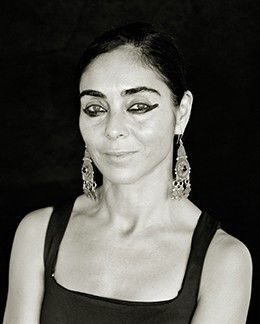By Sara Damavandan
William Shakespeare is widely regarded as the greatest writer in the English language. He is the author of a tragicomedy called “The Tempest,” which is believed to have been inspired by real-life accounts and voyager journals.

A trio of Iranian talents recently featured in a critically acclaimed stage production of The Tempest in Poland – directed by choreographer Krzysztof Pastor. Visual artists Shirin Neshat and Shoja Azari created stunning videos for the production, while actor-percussionist Abbas Bakhtiari played the lead: Prospero, Duke of Milan. The Polish press described this version of The Tempest as one of Polish National Ballet’s finest recent performances.
Mr. Bakhtiari recently spoke to Kayhan London about the production.
Why was this play chosen among the works of William Shakespeare?
The Tempest is one of Shakespeare’s most exceptional masterpieces. If you see this production, you will realize how much it is relevant to today’s world events and to mankind’s continued suffering. Shakespeare’s Tempest strangely reminded us of the migration and death of the Syrians, Afghanis and Iranians who recently lost their lives in the stormy seas.
During the storm scene, the ship breaks apart and people are swallowed up by the thrashing waves. While performing the part, I would instantly think of the four-year-old Syrian boy, Aylan, whose body was washed up on the beach, or the mother who drowned at sea along with her three children. I would get terribly upset, sometimes even teary-eyed. It is as if I were personally experiencing these deaths.
The Polish government recently passed a law banning all refugees from entering the country. This compounded my bitterness. We are artists, and an artist’s mission is to defend the honor of mankind.
How did the idea for the production first come up?
Willem Bruls, the Dutch author and playwright, suggested this work to Mr. Pastor, a famous choreographer who works both with the Polish National Ballet and the Dutch National Ballet. Until then, the piece had been staged as a play. This time, preference was given to a different type of theatrical production – one that also involved ballet.
Naturally, integrating The Tempest with ballet and other art forms was a difficult task. Ms. Shirin Neshat and Mr. Shoja Azari were among the visual artists to whom the project was proposed. Ms. Neshat also designed the poster.
The production was the culmination of two years of discussions. Mr. Pastor directed the Polish National Ballet’s 30-member corps de ballet, brilliantly accompanied by the Warsaw Symphony Orchestra.
How were the performers selected?
The selection of the lead actor was very difficult. They needed someone both who was both qualified and who could, through music, provide a link between the four scenes in the show.
I was selected by Ms. Shirin Neshat and Mr. Shoja Azari. Mr. Pastor was already familiar with my work. After a series of discussions, we came up with a workable project, where I would both act and play music.
At first, we didn’t understand each other very well. Two weeks after the start of rehearsals, Ms. Neshat, Mr. Azari and Mr. Pastor asked for my opinion. Mr. Pastor was very happy with the way things were going. I was not at all pleased with my work. I felt unable to express my creativity. I told the director that I didn’t like to feel imprisoned, and asked him to let me improvise.
He was reluctant at first. I was then given free rein. I concentrated all of my efforts into presenting my acting and musical capabilities: specifically, to introduce Iranian music, using a classical percussion instrument, in Shakespeare’s Tempest.
What instruments were used?
To evoke the storm, I used two Daf frame drums that I played solo or simultaneously. It was a very difficult exercise and gave me muscular cramps. I even ended up in the hospital because of all the pressure. We also used the cajon, which is a Spanish percussion instrument.
We staged eight performances in Amsterdam. Everyone seemed pleased with the work. But after watching the film of the ballet several times, we noticed some problems.
As a result, our performance in Warsaw was very different. Instead of using rhythm, we used sound to depict the storm and the various episodes in the story. It was a much better work, particularly since I was given freedom as an actor.
The performance was incredibly well received. What was special about it?
Four years is a long time to stage a production. Also, both in the Netherlands and in Poland, we benefited from the budgetary backing and superior facilities of the Ministry of Culture and of the government.

